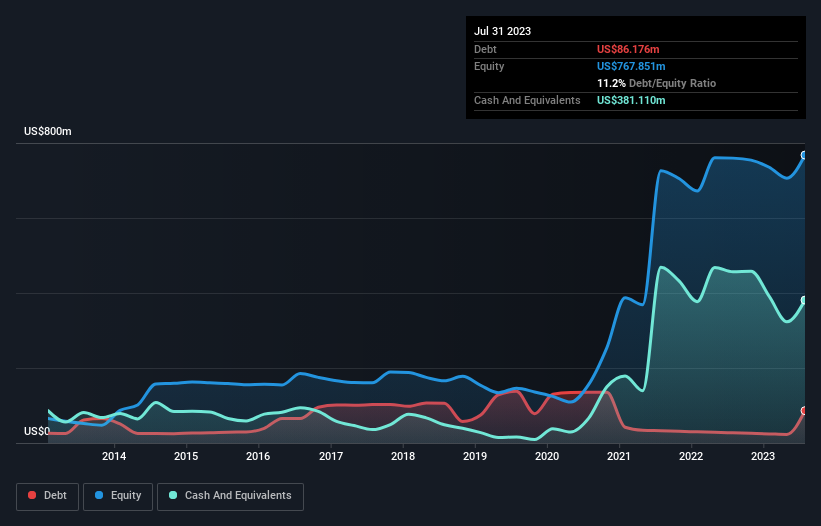- United States
- /
- Electrical
- /
- NasdaqGM:FCEL
Health Check: How Prudently Does FuelCell Energy (NASDAQ:FCEL) Use Debt?
Howard Marks put it nicely when he said that, rather than worrying about share price volatility, 'The possibility of permanent loss is the risk I worry about... and every practical investor I know worries about.' When we think about how risky a company is, we always like to look at its use of debt, since debt overload can lead to ruin. We note that FuelCell Energy, Inc. (NASDAQ:FCEL) does have debt on its balance sheet. But is this debt a concern to shareholders?
When Is Debt Dangerous?
Debt and other liabilities become risky for a business when it cannot easily fulfill those obligations, either with free cash flow or by raising capital at an attractive price. If things get really bad, the lenders can take control of the business. However, a more usual (but still expensive) situation is where a company must dilute shareholders at a cheap share price simply to get debt under control. Of course, debt can be an important tool in businesses, particularly capital heavy businesses. When we think about a company's use of debt, we first look at cash and debt together.
View our latest analysis for FuelCell Energy
What Is FuelCell Energy's Debt?
You can click the graphic below for the historical numbers, but it shows that as of July 2023 FuelCell Energy had US$86.2m of debt, an increase on US$27.1m, over one year. But on the other hand it also has US$381.1m in cash, leading to a US$294.9m net cash position.

A Look At FuelCell Energy's Liabilities
We can see from the most recent balance sheet that FuelCell Energy had liabilities of US$59.0m falling due within a year, and liabilities of US$118.4m due beyond that. Offsetting this, it had US$381.1m in cash and US$29.1m in receivables that were due within 12 months. So it can boast US$232.8m more liquid assets than total liabilities.
This excess liquidity is a great indication that FuelCell Energy's balance sheet is almost as strong as Fort Knox. Having regard to this fact, we think its balance sheet is as strong as an ox. Simply put, the fact that FuelCell Energy has more cash than debt is arguably a good indication that it can manage its debt safely. When analysing debt levels, the balance sheet is the obvious place to start. But ultimately the future profitability of the business will decide if FuelCell Energy can strengthen its balance sheet over time. So if you're focused on the future you can check out this free report showing analyst profit forecasts.
Over 12 months, FuelCell Energy reported revenue of US$140m, which is a gain of 33%, although it did not report any earnings before interest and tax. Shareholders probably have their fingers crossed that it can grow its way to profits.
So How Risky Is FuelCell Energy?
We have no doubt that loss making companies are, in general, riskier than profitable ones. And the fact is that over the last twelve months FuelCell Energy lost money at the earnings before interest and tax (EBIT) line. Indeed, in that time it burnt through US$219m of cash and made a loss of US$123m. Given it only has net cash of US$294.9m, the company may need to raise more capital if it doesn't reach break-even soon. With very solid revenue growth in the last year, FuelCell Energy may be on a path to profitability. By investing before those profits, shareholders take on more risk in the hope of bigger rewards. There's no doubt that we learn most about debt from the balance sheet. However, not all investment risk resides within the balance sheet - far from it. To that end, you should learn about the 4 warning signs we've spotted with FuelCell Energy (including 1 which is significant) .
If, after all that, you're more interested in a fast growing company with a rock-solid balance sheet, then check out our list of net cash growth stocks without delay.
New: AI Stock Screener & Alerts
Our new AI Stock Screener scans the market every day to uncover opportunities.
• Dividend Powerhouses (3%+ Yield)
• Undervalued Small Caps with Insider Buying
• High growth Tech and AI Companies
Or build your own from over 50 metrics.
Have feedback on this article? Concerned about the content? Get in touch with us directly. Alternatively, email editorial-team (at) simplywallst.com.
This article by Simply Wall St is general in nature. We provide commentary based on historical data and analyst forecasts only using an unbiased methodology and our articles are not intended to be financial advice. It does not constitute a recommendation to buy or sell any stock, and does not take account of your objectives, or your financial situation. We aim to bring you long-term focused analysis driven by fundamental data. Note that our analysis may not factor in the latest price-sensitive company announcements or qualitative material. Simply Wall St has no position in any stocks mentioned.
About NasdaqGM:FCEL
FuelCell Energy
Manufactures and sells stationary fuel cell and electrolysis platforms that decarbonize power and produce hydrogen.
Flawless balance sheet with low risk.
Similar Companies
Market Insights
Community Narratives



